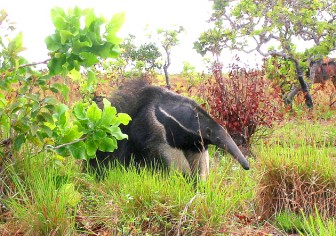It’s more than six feet long with a great bushy tail, long snout, and big claws on its front feet. It ambles along in the savannah and forest looking for ant and termite nests for food. What is it? The Makushi call it ‘Tamnuwa’;
we on the coast call it the Giant Anteater, and it is truly a giant. The largest species of anteater in the world, this animal exists in the grass and savannah lands of Central and South America and is mainly solitary. The scientific name for the Giant Anteater is Myrmecophaga tridactyla; this literally means ‘ant eater with three toes’ and describes this strange animal appropriately, although the Giant Anteater really has 5 toes. The three middle digits of the forefeet have elongated nails which they use to rip open ant and termite nests, their primary food source.

This species exists from Central to South America and in the early morning and late afternoon, in the savannahs of the Rupununi they can be seen roaming the grasslands and forest looking for termite castles and ant hills. Giant Anteaters use their long sticky tongues, which can grow up to 50 cm, to grab their food. And although they don’t have teeth they can eat up to 30,000 insects a day, crushing them with hard growths on the insides of their mouths. Their long hair and thick skin protect them from the stings of the ants and termites they are raiding and the texture and pattern of their fur cleverly camouflage them in the long savannah grasses where they range.
During the heat of the day, the Giant Anteater curls up in the cool shade of trees and bushes, pulls its tail over itself like a blanket and rests.
The Makushi believe that the blood and hair of the Giant Anteater, burnt to ashes and mixed with a hair cream can cure or prevent male pattern baldness.
Habitat destruction is listed as the primary threat to this animal and the International Union for Conservation of Nature (IUCN) has listed it as “vulnerable.” Not much is known about the habit or reproduction of the Giant Anteater, but in the Rupununi, adult individuals can be seen roaming the savannahs, sometimes with a young one hitching a ride on the back of its mother.
Rain forests are rich in biodiversity and are home to many different plants and animals. In addition, indigenous communities make their homes there. Even if you don’t live in the rain forest, humans rely on the forest for resources such as building materials (wood and lianas), medicine and fruits. Rain forests also provide essential environmental services for life on earth; they create soil as well as prevent soil erosion, produce oxygen though photosynthesis, maintain clean water systems, and are a key defence against climate change.
The Iwokrama Rain Forest is 371,000 hectares, located in the heart of Guyana. Our mission is to develop strategies for conservation and sustainable development for local people in Guyana and the world at large. We are involved in tourism, training, research and our timber is certified by the Forest Stewardship Council. Come and visit us in the rain forest or at http://www.iwokrama.org.




